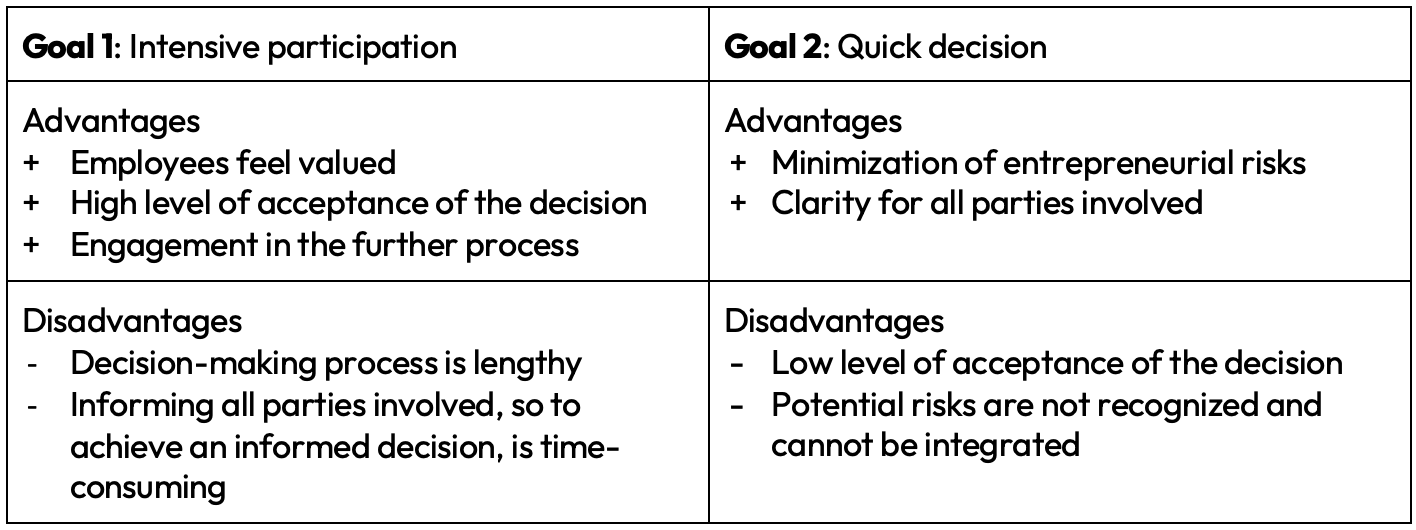One of the core tasks of leadership is to manage paradoxes. In this series of articles, I present an approach on holistic paradox management.
For each paradox, we need an approach for how to manage it. We first start on a cognitive-rational level – our ‘head’. This requires four steps:
- Make ourselves aware of paradoxes
- Work out advantages and disadvantages per page
- Define a higher goal
- Derive approaches to managing the paradox
Step 1 – Making Paradox Aware
To start off, it is important to be aware of the paradox in the first place: what causes a stomachache in a given situation? What contradictory values and goals are at stake? Being aware of paradoxes is often easier said than done. In our everyday lives, managers often face high pressure environments, and are forced to make quick decisions and act on them. As a result, leadership decisions may be made without the awareness of a paradox. What remains: a bad gut feeling and inner turmoil because there is no single correct solution. Again, here is the example from the first article: On the one hand, employee involvement is an important quality for a manager. On the other hand, in a situation where decisions must be made quickly, there may not be enough room for intensive participation.
Step 2 – Work Out the Pros and Cons per Page
Alternatively, if we are aware of the paradox in a leadership situation, we can deal with it proactively. Therefore, we manage the situation consciously and with clarity about the consequences of the decisions. To do this, we first work out the advantages and disadvantages of both sides with the help of the Paradox Management Grid.
Fig. Paradox Management Grid – Example of participation

Step 3 – Define a ‘Higher Goal’
Paradoxes need to be managed not only in the short term, but also in the long term. For this, it helps to define a ‘higher goal’ that unites both sides in some way. This describes what you basically want to achieve and why something is important to you as a leader.
Fig. A ‘Higher Goal’ that Unites Both Sides

For most paradoxes, it is also possible to define a hierarchy of goals or values. This means that, at least in the long run, a goal or value is more important. In the example, this would probably be the intensive involvement of employees. Although this does not necessarily create clarity in a concrete situation, it makes it possible to manage a paradox in the long term.
Step 4 – Derive Approaches to Managing the Paradox
After defining a higher goal, managers can now derive actions for a specific situation, according to the motto “There is nothing good unless you do it”. A derived leadership behavior (action items) could look like this, for example:
- Clarification of decision-making processes, considering different levels of employee/team participation.
- Creation of transparency about situational requirements and the derived degree from participation in a decision.
- If quick decision-making is required: Involve stakeholders via a representative feedback query.
- Questioning time-critical decision: Discuss timelines with relevant stakeholders to ensure as much participation as possible.
In addition to such concrete implementation measures, it is also important to ensure that the paradoxes are successfully managed in the long term by introducing routines. Routines can be developed individually for the manager, but also for the entire team. For example, regular, monthly, or quarterly retrospectives can be used to jointly evaluate whether the balance between participation and speed has been achieved.
It is also important for managers to deal with the stress induced by the paradox. This is what the next blog post ‘Emotional Paradox Management’ will deal with.
